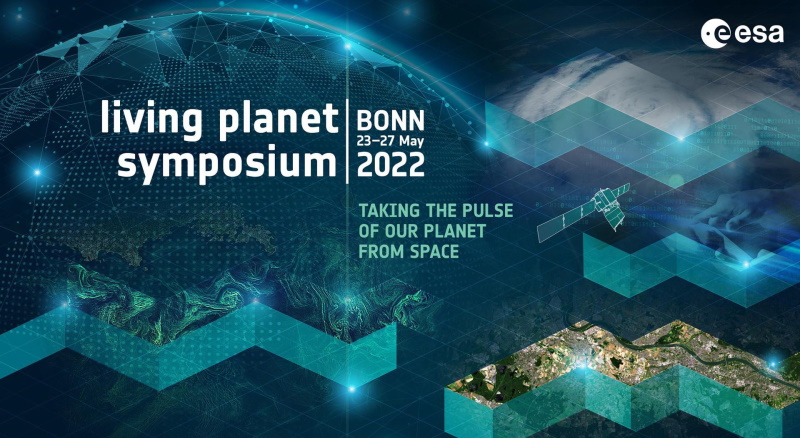- News & Events
- Living Planet Symposium hosts ...
Living Planet Symposium hosts a plethora of meaningful scientific sessions
20 May 2022

Remote sensing scientists and data users are set to highlight how they use ESA's Earth observation data to enable cutting-edge research and development activities at a series of scientific sessions held at the Living Planet Symposium.
Starting Monday, the global community of remote sensing scientists and researchers will convene at the Living Planet Symposium 2022. Taking place from 23 to 27 May, at the World Conference Center in the German city of Bonn, the symposium aims to showcase the latest advances in Earth observation and highlight the essential role of Earth observation for decision making around the climate crisis.
As we reach a crucial junction in the global response to the climate crisis, monitoring the changes in Earth's system is more important than ever. European satellites orbiting Earth provide up-to-date information about our changing world, giving essential input to international climate policymakers. The data from these satellites fuel many critical applications and research within the Earth observation community.
The Living Planet Symposium is a forum where the latest findings in Earth observation are presented and discussed. It is a unique opportunity to foster partnerships, explore new concepts within remote sensing, and learn about the latest developments from ESA's many fleets of Earth observation satellites.
The delivery of data from the agency's Heritage Space Programme helps meet the global demand for long-term information on Earth's environment. On Tuesday 24 May there will be a full day of sessions at the symposium revealing recent uses and perspectives on Heritage Missions. Raising topics such as the 40 years of AVHRR-Local Area Coverage data, multi-decadal SAR imagery archives and the benefits of 20 years of ERS and Envisat data, the multiple sessions will explore lessons learnt and possible further improvements as the community leverages these long-term datasets.
Very High Resolution in focus
Examining Earth with high resolution is proving hugely useful for a range of applications, such as land-mapping, extreme weather response and maritime surveillance. A growing number of very high resolution (less than 30 cm) satellites have been launched recently, many delivering their data as part of ESA's Third Party Mission Programme (TPM).
Also on 24 May, there will be a focus session on the improvements in VHR data offerings from several TPMs: COSMO-SkyMed Second Generation provides improved VHR modes and quality, ICEYE SAR data enables persistent monitoring, WorldView-3 data facilitates methane emissions mapping, and the introduction of Vision-1 to the TPM Programme. An agora demonstration session will explain how Pléiades Neo can be leveraged for defence and security applications.
Research mission updates
A gathering which serves as a check-in point for Earth's system would not be complete without an opportunity to hear updates on ESA's family of research missions, the Earth Explorers. From 25 to 27 May there are a range of sessions on the current and future Explorer missions.
The scientific highlights and status of the flying missions SMOS, CryoSat, Swarm and Aeolus will be showcased, and there are multiple presentations on the photosynthesis mission, FLEX, ESA's new forest mission Biomass and ESA's cloud mission EarthCARE, giving updates on the project development status, data exploitation plans, validation status and campaign plans. The candidate missions TRUTHS and Harmony will also be aired.
Data users' perspectives
The increase in VHR missions has raised the need for harmonised calibration and validation of VHR data, which is discussed in a session on optical sensor products. On data use, there is a designated event to discuss and collect best practices, suggestions and recommendations on topics such as Cal/Val assessment, data quality assessment, and potential approaches to a usability assessment framework.
Furthermore, an entire morning session on 24 May, will address how emerging technologies enhance data users' perspectives. Novel platforms such as HeatR, which generates harmonised, multisensor land surface temperature time series will be presented, as well as ESA's PDGS Data Cube service and the GEO (COVERAGE) platform, which aims to simplify the use of ocean data.
Release of new Data Access Guide
During the Symposium the new Third Party Missions Data Access Guide will be published. This is your go-to guide to the offering of TPM data (from current or past missions), including the collection descriptions and how to access them. The 2022 version of this guide has been largely revised and, with respect to the 2020 version, includes many new data collections provided by recently available satellites in the TPM portfolio, such as Pléiades Neo , Iceye, PlanetScope, Planet SkySat and Vision-1.
ESA is taking the opportunity of the Symposium to invite feedback on its data access and services through an online survey. Take 10 minutes to share your experience in using data, which will help improve the range and quality of the data and services offered.
We look forward to a fruitful week of lively discussions and presentations in the pulsing heart of the Earth observation community. Make sure to visit our Data Discovery and Access booth to learn more about the missions and data access for Earth Explorers, Third Party missions, and Heritage Missions.
Highlights and news announcements during the Living Planet Symposium will be published on Earth Online throughout the week.